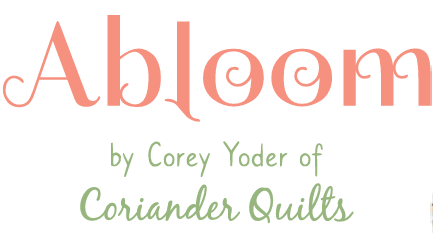Hand Quilting Part 3

Welcome back to part 3 of your Hand Quilting series. Today we are going to be talking about hand quilting techniques.
Last summer, I filmed a series of videos with Fat Quarter Shop on hand quilting. Rather than re-explaining what I’ve mentioned in the video, I am going to share it here and refer to it throughout this blog post. There is a lot of information in this video, the actual hand quilting portion begins at about the 12 minute mark. At about 20:40, I am showing how to finish thread in the middle of a project. I have since changed my method for doing this and will share that information a little bit further down in this post.
First off, I have just released a new mini quilt pattern, Freshly Cut Mini that I am currently hand quilting. This is the large version:

Freshly Cut pattern--you can find the pattern for the large version of the quilt here.
And here is my mini version (pre-hand quilting). The mini version finishes at just 20 1/2″ x 24 1/2″–so cute! I have marked my hand quilting lines (you see them in blue) and have made my pillow sandwich using the spray basting technique mentioned in the video.

For my backing fabric, I am using a left over piece of one of my Canning Day 108″ wide backs. I don’t recommend this fabric for hand quilting (although I didn’t have too much trouble with it). Any fabric with a higher thread count is not going to be as nice to hand quilt with. In part 2 of my hand quilting series, I mentioned that batiks were an example of a fabric that is harder to hand quilt.

However, on small projects, we can make things work that we might choose not to use on a larger project.
Next, I laid out some of my threads to see what colors I wanted to use. I recommend doing this before marking your quilt top as it can be hard to get a really good idea with those blue lines on your top. Keep in mind when choosing thread colors that how it looks on your spool will be darker than how it looks on your top. Laying out thread is also a great way to choose how you might want to quilt your quilt top. If you are unsure of how you want to make your top, lay some threads out.

I prefer less complex patterns for big stitch hand quilting. Because of the gap between stitches, a complicated design will lose it’s shape pretty quickly. I often opt for straight lines–occasionally gentle curves depending on the project. Another thing, I tend to treat borders as an extension of the quilt center–often taking my quilting lines straight through them rather than doing something different. This is different than you would see done with smaller hand quilting stitches..and it’s a personal preference.
When marking quilting lines, it is not fun to stitch through a seam allowance..so keep that in mind as well.

Threads chosen, Aurifil 12 weight
After marking my quilt top, choosing my threads, making my quilt sandwich, I am ready to begin quilting. I will be starting with one of the stitching lines in the center of the quilt. After completing a center line, I will be skipping several lines to the left and I’ll hand quilt a line. And then, go back to the center, skip several lines to the right and quilt a line. This keeps everything in place, and then I go back in and add lines in the same manner.
If I have lines going horizontally and vertically, I do both directions in this way, alternating directions; a horizontal line, then a vertical line.
When marking quilting lines, it is not fun to stitch through a seam allowance..so keep that in mind.

Just some pretty hand quilting. =)
The stitches we need to know for hand quilting: Quilter’s Knot (a great way to make a knot & Rocking Stitch, as well as a French knot. I talked about both of these in the video and showed how to do them. I’d also recommend going on YouTube and watching additional videos on both of those techniques. There are a lot of great videos to watch and you’ll probably learn something new and different from each one.
In addition to the stitches, you will need to know how to stop/start your threads in the middle of a project. We don’t want any knots on the back of our quilt, so those get buried in the batting of our quilt if we stop/start in the middle. I cover how to do this in the video as well.
Since filming the video, I have changed how I finish thread in the middle of a project. This is an easier technique and works wonderfully. Starting at the 20:40 minute mark in the video here is the updated version.
(I am working on a scrap quilt sandwich so just pay attention to the quilting line I am currently working on)

Finish your stitch and then come up right at the beginning of the stitch just as in the video.
In the photo above, this is the part where you have finished your last stitch and come up at the beginning of that same stitch. In the video, you saw me go through the end of that stitch next. Instead, we are going to make our knot right now (rather than after completing that stitch as shown in the video).
The knot is the same knot you saw me make in the video–basically just a french knot. I made the knot and circled it in the photo below. You will want it to be about 1/4″ away from the end of that last stitch. If you are a cross-stitcher and this happens during a french knot, it is quite frustrating!–but for our purposes, it’s just what we want.

Then, you will go through the end of your last stitch and come up through the quilt top (you are in the batting, not through the backing). See the photo below. You saw me do this part in the video–I didn’t have the knot on my thread yet in the video. Wiggle your needle through the batting as you do this step. This will cause the knot to go through the batting when we pull it through (securing it more fully) and will also help any dark thread from shadowing under your quilt top. I circled the knot again in the photo below so you can see where it is.

Next, you are going to pull your knot through. You can see in the photo below that it has snugged right against the quilt top. Just pull the thread through.

Once the knot has popped through, you will trim your thread tail (close to the quilt top). If you have any tail showing on the top of your quilt, just work it down with your needle.

And, your thread is secured. I like showing this on white fabric so you can see how it can shadow through if you don’t work your thread through your batting when you “wiggle” underneath. Additionally, if you can stop and start your thread underneath a printed portion of your quilt you won’t be able to see your threads shadowing through. Pay attention to those stops and starts so you can do them at a great spot–under printed fabric and not close to any seam allowances.
If I am working on something small, I will use a piece of thread long enough to get me across my project so that I don’t have to stop and start.
Next week, I will be back with my completed Freshly Cut mini quilt. I will be answer questions that I received earlier that I haven’t had a chance to cover. If you have questions, feel free to leave them for me below.
And if you missed Part 1 of my hand quilting series you can find it here, and Part 2 here.
Have a beautiful weekend! Corey





























Great post, Corey! Thanks for all these tips for big-stitch quilting.
You are so welcome!l–thank you for following along!
Thank you for the hand quilting tutorials. I have been enjoying the big stitches and love the look that they add. What is the background fabric that you used on your mini? I just looked back through your collections and can’t find it. Thanks!
It’s from my upcoming Holliberry collection coming out in July. It’s such a great background print!
I’ve been looking forward to this post. Thank you! Off to watch the video portion.